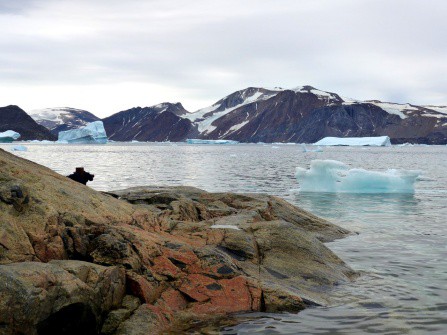In climate science, the conventional wisdom is that the Greenland Ice Sheet — the world’s second-largest block of ice — formed some 2.5 million years ago and endured continuously until modern times.
But a new study is challenging this notion, hinting that Greenland may have been nearly free of ice for much of this period, says Jason Briner, a University at Buffalo geologist who co-authored the research. This finding comes from geologic evidence, from a sample of the bedrock that lies below the ice sheet. An analysis found that this surface was exposed to open sky for at least 280,000 of the last 1.4 million years.
The results were a “complete surprise,” Briner says. They point to an unsuspected volatility in the ice sheet, suggesting that it may not take much more warming for the ice to disappear completely, causing a spike in sea levels worldwide, he says.
The study, which will be published on Dec. 8 in the journal Nature, was led by Joerg Schaefer, PhD, at Columbia University’s Lamont-Doherty Earth Observatory.
Briner was one of several co-authors on the multi-institution project, which also included the University of California, Berkeley; the Berkeley Geochronology Center; Pennsylvania State University; Purdue University; and the U.S. Army Cold Regions Research and Engineering Laboratory.
To arrive at their conclusions, the scientists investigated the bedrock beneath a key part of the ice sheet: the summit, a location that climate models show would be one of the last to lose its ice in the event of a complete meltdown.
The bedrock contains aluminum and beryllium isotopes, and the ratio of these isotopes to one another reveals information about how long the bedrock has been exposed to the sky over a given length of time.
In the case of the chosen site, an analysis showed that the bedrock had been bared to the sky — and, therefore, free of ice — for at least 280,000 of the last 1.4 million years. While it’s possible that all of the exposure occurred during a single ice-free period, it’s more likely that the ice vanished multiple times for shorter stretches, the scientists say.
“The Greenland Ice Sheet likely shrank down to almost zero during extended periods of time when we thought it was much more stable,” says Briner, PhD, an associate professor of geology in UB’s College of Arts and Sciences. “We’ve just learned that the ice sheet has a weak underbelly, that it may not take much more warmth for it to go away completely.”
“Unfortunately, this makes the Greenland Ice Sheet look highly unstable,” said Schaefer, a paleoclimatologist. “If we lost it in periods of natural forcing, we may lose it again.”
The bedrock sample the researchers used came from a rock core — a cylindrical sample of rock — recovered in July 1993 by a U.S. scientific team working in southeast Greenland. It took them five summers to drill through 3,056 meters (about 10,000 feet) of ice and sediment. Then they punched 1.55 meters (5 feet) into the underlying bedrock. Scientists tried early on to analyze the rock, but only in the last year or so have lab techniques become sophisticated enough to tease out the needed information, says co-author Robert Finkel of the University of California, Berkeley.
Briner, an expert on the history of Arctic ice, contributed to the project by helping to interpret data, assisting the team in telling the story of why the scientific results were significant in the context of the region’s past.
While scientists have known for some time that ice sheets in Canada and the United States repeatedly expanded over vast distances before completely disappearing again over the past 2 million years, the Greenland Ice Sheet was thought to be more stable — until now.
“Because the forcing of climate has a heartbeat, with ice sheets expanding and shrinking in a periodic pattern, our results suggest that the Greenland Ice Sheet likely zeroed out at multiple points in the past 2.5 million years,” Briner says.
“If that happens again — this time due to global warming — it would raise sea level by about 24 feet and add to sea level rise from melting in Antarctica,” he adds. “This would have devastating consequences, ranging from profound economic burden to a widespread coastal refugee crisis.”
To better understand the sensitivity of the Greenland Ice Sheet to climate change, Briner, Schaefer and colleagues are collaborating on a new National Science Foundation-funded study. This new research, led by Briner, will examine how anticipated changes in Arctic precipitation could influence the ice sheet’s rate of decline.
If our reporting has informed or inspired you, please consider making a donation. Every contribution, no matter the size, empowers us to continue delivering accurate, engaging, and trustworthy science and medical news. Independent journalism requires time, effort, and resources—your support ensures we can keep uncovering the stories that matter most to you.
Join us in making knowledge accessible and impactful. Thank you for standing with us!

